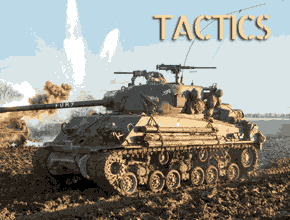The T34 heavy tank was a new heavy tank design, evolving from the T29 and T30 prototypes of 1945. The T34 was using the same chassis, but had a new modified T53 120 mm gun (M1) anti-aircraft gun and extra armor plating to the turret bustle as counterweight for the new cannon. The production was not authorized as the Army after its tests eventually found it too heavy. The project evolved into the M103, which was standardized and produced to counter the Soviet IS-3 and its successors, IS-7 and IS-10.
Which led to a simple idea, the same the germans had for their massive Jagtiger and never-built prototypes using this caliber. On the US side, tank gun derived from the 120 mm M1 was not forthcoming as the US Army preferred to focus on the more rapidly ready, longer 90 mm guns as well as new 105 and 155 mm guns worked on for a sucessor to the M26 Pershing. By early 1945 a study of compared effectiveness of tank guns existing or in projects revealed the 120 mm AA gun was however an ideal candidate for conversion.

It was indeed long at 7,391 mm without muzzle brake, but the T15E2 90mm of the Heavy Tank T32 prototype was just 10 inches shorter. The 105 mm gun T5 was shorter by 13 inches. The 120mm had a much higher muzzle velocity, and thus, unrivalled penetration, with a projectile heavier with better hitting characteristics. Overall, they mirroed the Soviet 1945 OBM-51 gun (BL-13), but the latter remained stcuk in development. From there, the carrier heavy tank was worked on for a start, as a simple derivative of previous T28/T30 prototypes.
T28 tank, armed with a 105mm tank gun
The idea of adapting the new M1 as a tank gun also required the development of a new heavy tank, which was initially to be a T30. The latter derived from the T28, which derived from the 1944 T26E3 Pershing (commer commonly known as the "super-pershing". The new 66 tonnes tank was tested in early 1945 wit a long-barreled 105 mm T5E1, and at least helped ironing out a few concept behind a pormising new platform, which was a bit more than a simple Pershing with an extra axle. The most concrete successor was designed to test another Ordnance tank gun project, this time a most impressive 155 mm gun. For it was the developed the Heavy Tank, T30.

The T30 shared the same chassis as the T29, but sported, for its enormous gun, which barrel was considerably shortened, a more cavernous turret. However the T30 experienced such issues that it was decided that the original T29 turret was a more promising base, the ideal carrier for the 120 mm, now known as the T53 tank gun. It was in May 1945 that the Ordnance Department recommended that two of the T30 pilots be armed with the 120mm gun, which became the heavy tank T34. The turret initially did not changed, but it was soon established that since the T53 gun was longer, half a ton heavier than the T5E1 105 mm, this needed a rebalancing the turret, now dangerously unstable. A simple emergency braking was supposed indeed perhapes even sufficient for the turret to simply leave the ring mount.
So it was decided to weld on a 102 mm thick plate at its back, acting as protection for the ammunition, but mostly as counterweight. The new tank gun mount developed was the T125, despite its similarities with the T123 on the Heavy Tank T29. There were also two coaxial machine guns. The Heavy Tank T34 prototypes, two of them, were built at the Detroit Tank Arsenal, the go-to development center and workshop for US tank prototypes. However with the war now ended, the program was not juged urgent, and the Aberdeen Proving Grounds only made the program public by April 1948.
Most of the changes made on the T34 were rrlated only to gunnery trials and notably a way to cope with their bulky ammunition, with a capacity identical to the T30 of 34 rounds. However it had much lighter ammunition and two loaders to help the operation, for a better rate of fire was 5 RPM. On gunnery trials, the T53 tank gun was able to defeat a 198 mm (7.9 inches) thick plate at 30° at 1000 yards away. I would have pierce the Maus from intermediate ranges and at close distance, frontally. Tests with a HVAP shot showed an even more impressive 381 mm (15 inches) at 1000 yards, 318 mm (12.5 inches) at 2000 yards (1.8 km). It could have destroyed any German tank, prospective even in 1945, but in 1947 mroe likel defeat the Soviet IS-3. Muzzle velocity however was not everything and the shell was considered "light" enough as if the plate was sloped to 60° degrees the AP shell only penetrated 102 mm (4 in), HVAP shell 112 mm (4.4 in). Meaning the frontal armour of an IS-3, well sloped, was thus immune.
Gunnery trials showed moslty a massive issue of fumes evacuation. It was just severaly lacking, given the amount of fumes was almost double of that of the 105 m (T5E1) without any changed in ventilation in the turret. So the amount of fumes collecting was downright dangerous, impairing the crew after a few shots. At Fort Knox, both loaders ended hospitalized, and the prototype at Aberdeen Proving Grounds suffered the same. Thus the second prototype received a fume extractor on the barrel. Previousy, solutions were proposed such as locking the breech, clearing it with compressed air. Trials after the fume extractor were successful. However the amount of recoil was also an issue. Not because the gun breech was dangerously close to the turret bustle's ammunition already, but because the recoil course put a heavy strain on every components, even the suspensions.
Thus, it was decided to install a new muzzle brake, this time on the first prototype. The second prototype eventually survived and is still on display today at the National Armor & Cavalry Museum, Fort Benning, Georgia.. In conclusion, neither the T29, T30, and T34 met production, but they played an important role, vital to inderstand where the Heavy Tank M103 came from, in May 1953. It should be recalled that originally the T29 (105 mm gun) and T30 (155 mm) were designed to engage and defeat the latter and prospective German tanks, on a lengthened version of the T26E3 chassis which remained compatible with the new logistics developed for the Pershing. In 1950 the new threat was the Soviet IS-3 and its successors. The conclusion of all three, when tests concluded in 1948, was that they were simply too heavy for the US Army and the Marine Corps requirements. Still in 1948 work started on a lightened version called the heavy tank T43, later standardized with the 120 mm intended, as the M103 Heavy Tank.
Development History
120 mm M3, the miracle gun
Tank gun development in the US before and during the war borrowed largely from AA guns, thanks to theior inherent muzzle velocity and range. This started already with the Medium Tank M3, and they were certainly not alone with this logic, which gave notably the German Tiger I and II. But there were exceptions too, such as the British 17-pdr. The US in WW2 in addition used towed AA guns for antitank purposes, and the top of the line on that matter was the gargantuan 120 mm M1. It was developed at first after WWI as the "one shot, one kill" ordnance capable of destroying high altitude bombers. The development went on in the interwar and only materialized in 1944, wit only a few manufactured and not even deployed. Indeed, by that time, using such as massive gun for AA purposes, without all the refinements of a more complex system (like the Navy cherished 5-in/38, with an evern greater caliber). The Ordnance Department however appreciated its exceptional characteristics, surpassing the German 128 mm Flak 40 in muzzle velocity but on a shorter barrel.Which led to a simple idea, the same the germans had for their massive Jagtiger and never-built prototypes using this caliber. On the US side, tank gun derived from the 120 mm M1 was not forthcoming as the US Army preferred to focus on the more rapidly ready, longer 90 mm guns as well as new 105 and 155 mm guns worked on for a sucessor to the M26 Pershing. By early 1945 a study of compared effectiveness of tank guns existing or in projects revealed the 120 mm AA gun was however an ideal candidate for conversion.

It was indeed long at 7,391 mm without muzzle brake, but the T15E2 90mm of the Heavy Tank T32 prototype was just 10 inches shorter. The 105 mm gun T5 was shorter by 13 inches. The 120mm had a much higher muzzle velocity, and thus, unrivalled penetration, with a projectile heavier with better hitting characteristics. Overall, they mirroed the Soviet 1945 OBM-51 gun (BL-13), but the latter remained stcuk in development. From there, the carrier heavy tank was worked on for a start, as a simple derivative of previous T28/T30 prototypes.
A modified T30 ?

T28 tank, armed with a 105mm tank gun
The idea of adapting the new M1 as a tank gun also required the development of a new heavy tank, which was initially to be a T30. The latter derived from the T28, which derived from the 1944 T26E3 Pershing (commer commonly known as the "super-pershing". The new 66 tonnes tank was tested in early 1945 wit a long-barreled 105 mm T5E1, and at least helped ironing out a few concept behind a pormising new platform, which was a bit more than a simple Pershing with an extra axle. The most concrete successor was designed to test another Ordnance tank gun project, this time a most impressive 155 mm gun. For it was the developed the Heavy Tank, T30.

The T30 shared the same chassis as the T29, but sported, for its enormous gun, which barrel was considerably shortened, a more cavernous turret. However the T30 experienced such issues that it was decided that the original T29 turret was a more promising base, the ideal carrier for the 120 mm, now known as the T53 tank gun. It was in May 1945 that the Ordnance Department recommended that two of the T30 pilots be armed with the 120mm gun, which became the heavy tank T34. The turret initially did not changed, but it was soon established that since the T53 gun was longer, half a ton heavier than the T5E1 105 mm, this needed a rebalancing the turret, now dangerously unstable. A simple emergency braking was supposed indeed perhapes even sufficient for the turret to simply leave the ring mount.
So it was decided to weld on a 102 mm thick plate at its back, acting as protection for the ammunition, but mostly as counterweight. The new tank gun mount developed was the T125, despite its similarities with the T123 on the Heavy Tank T29. There were also two coaxial machine guns. The Heavy Tank T34 prototypes, two of them, were built at the Detroit Tank Arsenal, the go-to development center and workshop for US tank prototypes. However with the war now ended, the program was not juged urgent, and the Aberdeen Proving Grounds only made the program public by April 1948.
Tests and Trials
Tank #2 (registed USA 30162833) started its trials at the time. This second prototype weight 65,136 kg, which was still below the T30. Mobility trials showed however the same disappointing performances as the T30. USA 30162832 was the initial prototype and only made a few runs at Aberdeed, and stayed there, but the second, which received later a fume extractor, was sent on August 18th, 1948, to Fort Knox for more testings. The trip, when it arrived proved a 80 km run. Firing trials were performed at range, until it was sent back for fixes at Aberdeen in December 1948 and a total of 136 km driven in more trials until mid-1949. The real star of the show at the time was the Heavy Tank T30. The T34 was mostly a polatform to test the 120 mm tank gun and mostly performed range trials.Most of the changes made on the T34 were rrlated only to gunnery trials and notably a way to cope with their bulky ammunition, with a capacity identical to the T30 of 34 rounds. However it had much lighter ammunition and two loaders to help the operation, for a better rate of fire was 5 RPM. On gunnery trials, the T53 tank gun was able to defeat a 198 mm (7.9 inches) thick plate at 30° at 1000 yards away. I would have pierce the Maus from intermediate ranges and at close distance, frontally. Tests with a HVAP shot showed an even more impressive 381 mm (15 inches) at 1000 yards, 318 mm (12.5 inches) at 2000 yards (1.8 km). It could have destroyed any German tank, prospective even in 1945, but in 1947 mroe likel defeat the Soviet IS-3. Muzzle velocity however was not everything and the shell was considered "light" enough as if the plate was sloped to 60° degrees the AP shell only penetrated 102 mm (4 in), HVAP shell 112 mm (4.4 in). Meaning the frontal armour of an IS-3, well sloped, was thus immune.
Gunnery trials showed moslty a massive issue of fumes evacuation. It was just severaly lacking, given the amount of fumes was almost double of that of the 105 m (T5E1) without any changed in ventilation in the turret. So the amount of fumes collecting was downright dangerous, impairing the crew after a few shots. At Fort Knox, both loaders ended hospitalized, and the prototype at Aberdeen Proving Grounds suffered the same. Thus the second prototype received a fume extractor on the barrel. Previousy, solutions were proposed such as locking the breech, clearing it with compressed air. Trials after the fume extractor were successful. However the amount of recoil was also an issue. Not because the gun breech was dangerously close to the turret bustle's ammunition already, but because the recoil course put a heavy strain on every components, even the suspensions.
Thus, it was decided to install a new muzzle brake, this time on the first prototype. The second prototype eventually survived and is still on display today at the National Armor & Cavalry Museum, Fort Benning, Georgia.. In conclusion, neither the T29, T30, and T34 met production, but they played an important role, vital to inderstand where the Heavy Tank M103 came from, in May 1953. It should be recalled that originally the T29 (105 mm gun) and T30 (155 mm) were designed to engage and defeat the latter and prospective German tanks, on a lengthened version of the T26E3 chassis which remained compatible with the new logistics developed for the Pershing. In 1950 the new threat was the Soviet IS-3 and its successors. The conclusion of all three, when tests concluded in 1948, was that they were simply too heavy for the US Army and the Marine Corps requirements. Still in 1948 work started on a lightened version called the heavy tank T43, later standardized with the 120 mm intended, as the M103 Heavy Tank.
T34 specs. | |
| Dimensions | 37.5 x 12.46 x 10.49 ft (11.4 x 3.8 x 3.2 m) |
| Total weight FL | 158,512 lb (71.9 t) |
| Crew | 6 (driver, gunner, loader, assistant loader, commander, assistant driver) |
| Propulsion | Continental AV-1790-5A AC 27.02 L: 810 hp (600 kW)/2800 rpm |
| Transmission | GM CD-850-1 crossdrive, 3 speeds |
| Suspension | Torsion-bar |
| Speed | 26 mph (42 km/h) road, 23 mph (37 km/h) off-road |
| Range | 350 US gal (1,300 L; 290 imp gal) c500 km |
| Armament | 120 mm T53 L/60 RF (34), 2x .50 in M2HB AA, .30 in M1919A4 bow |
| Armor | Max turret Front 305 mm (12 in) |
| Prod. | 2 Prototypes |
Illustrations

Photos
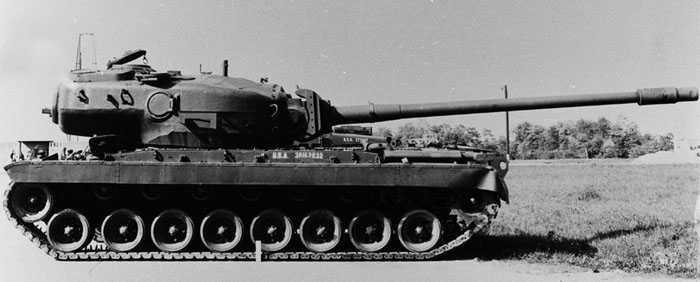
1st Heavy Tank T34 a new muzzle brake and a fume extractor were added
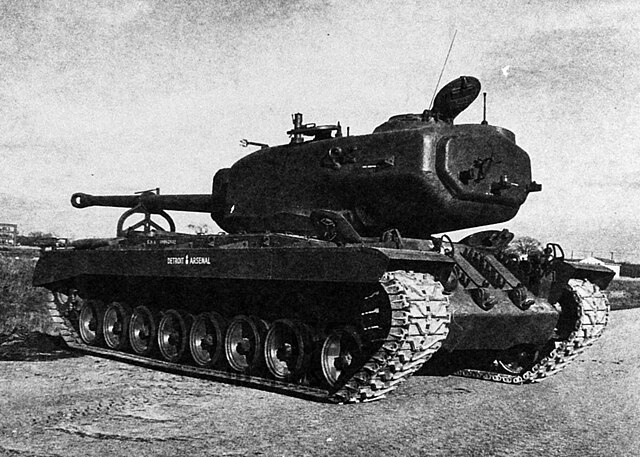
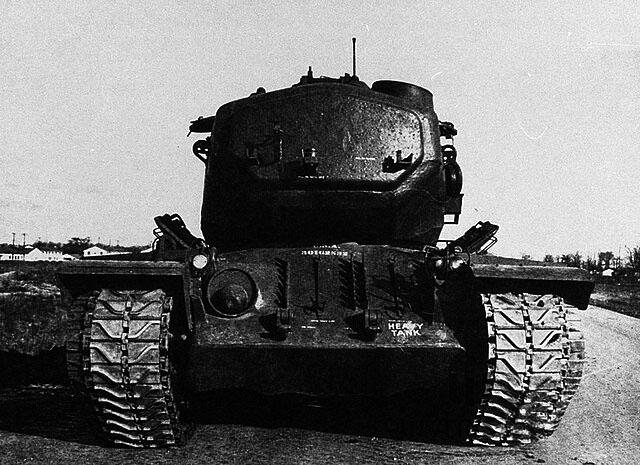
Heavy tank T34 N°30162832 remained at the Detroit Tank Arsenal, 1948
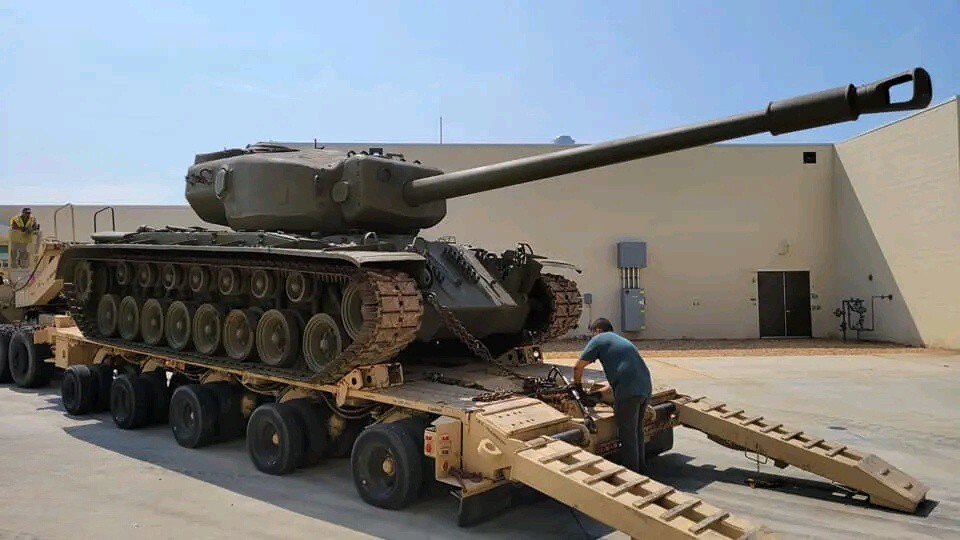
T34 heavy Tank in US Army Armor Cavalry Coll. 2021
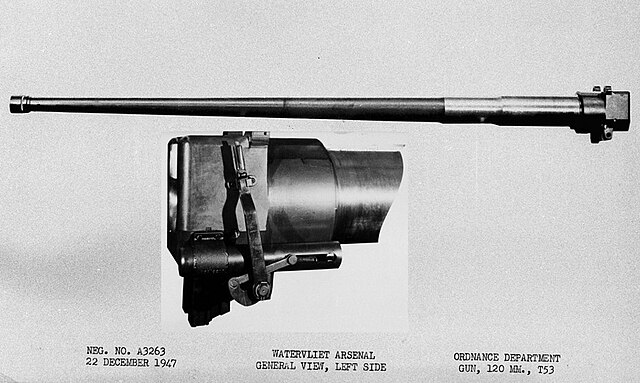
120 mm T53 gun used in the Heavy Tank T34
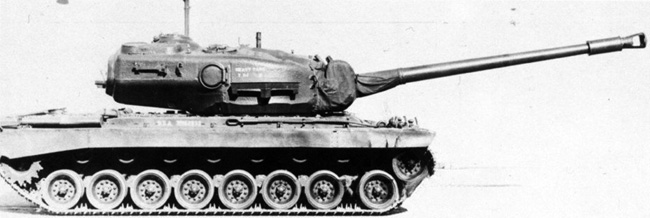
Second prototype fume extractor
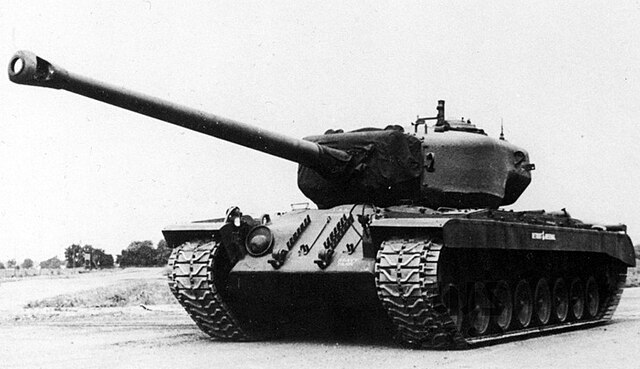
Second T34 prototype at the Aberdeen Proving Grounds 1948
More
Books
Hunnicutt, R.P. (March 1, 1988). Firepower: A History of the American Heavy Tank. Presidio Pr. p. 94.Links
maschinenkrueger.comguns.com
Video
Model Kit:
thearmoredpatrol.com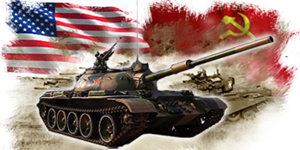
Cold War Tanks


































Cold war tanks posters
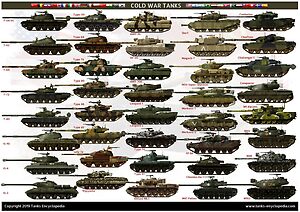
Cold War Main Battle Tanks
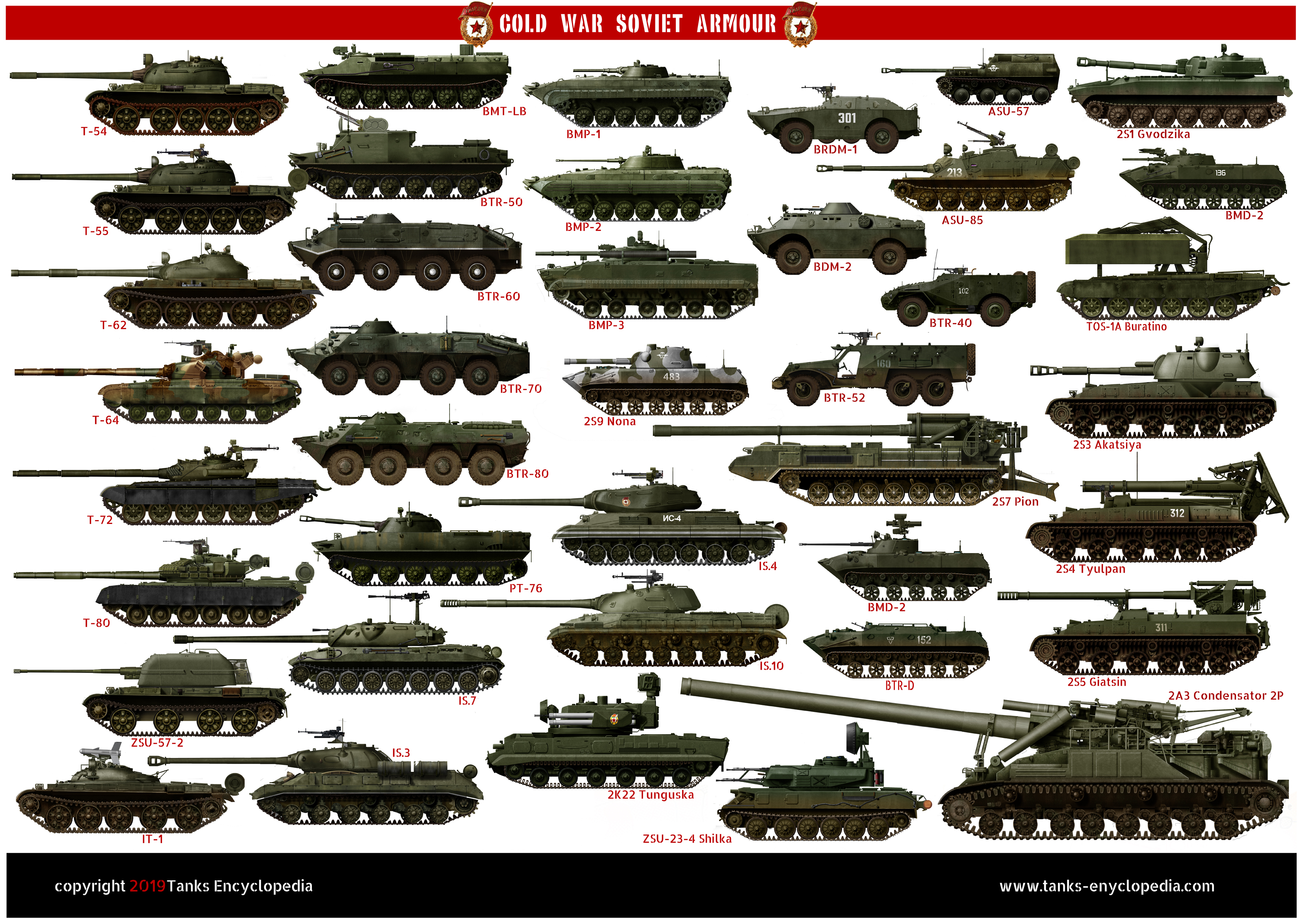
Cold War Soviet Army
Museums, Movies, Books & Games
The Tanks and Armor in pop culture
Tanks and armored vehicles in general are only really grasped when seen first person: The mass, the scale, it's all there. Explore also the way tanks were covered in the movie industry, in books and in video games.Movies:
Best tanks movie on warhistoryonline.com
On imdb.com
On bestsimilar.com/
miltours.com
liveabout.com/
watchmojo.com
Video Games:
pcgamesn.com
historyhit.com
levvvel.com
vg247.com/best-tank-games
mmobomb.com/
alienwarearena.com
